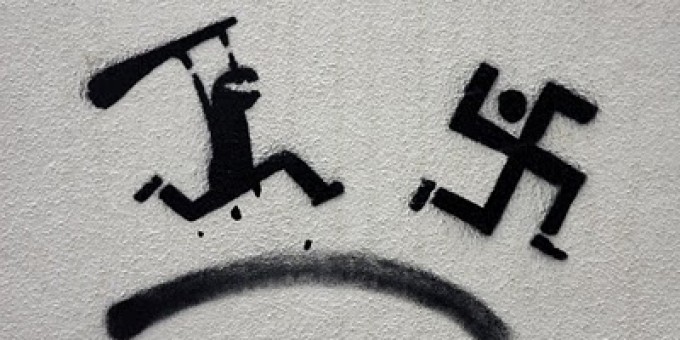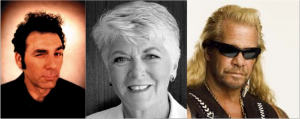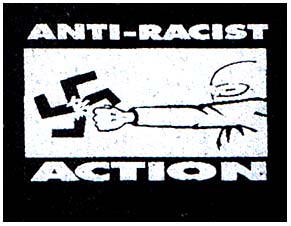
Deconstructing Racial Dualities
“It might even be possible that what constitutes the value of those good and respected things, consists precisely in their being insidiously related, knotted, and crocheted to these evil; and apparently opposed things—perhaps even in being essentially identical with them.”
—Friedrich Nietzche, “Beyond Good and Evil” (1886)
Western societies possess a fetish for the conflict between polar opposites. And when it comes to the “hot button” topic of race, these opposites seem all the more useful. We often make sense of racial conflict by searching for the quintessentially “good” and “evil” people involved.
Such lumping and splitting is nothing new. Scholars have long noted the framing of absolute rights and wrongs when it comes to racial identity and racism. Sociologist Jack Niemonen has written that we often, “…paint a picture of social reality in which battle lines are drawn, the enemy identified, and the victims sympathetically portrayed. …[Distinguishing] between ‘good’ whites and ‘bad’ whites.” And Eduardo Bonilla-Silva makes the point that scholars can impose their worldview in their evaluation of data: “Hunting for ‘racists’ is the sport of choice of those who practice the ‘clinical approach’ to race relations—the careful separation of good and bad, tolerant and intolerant Americans.” For his part, journalist Tim Wise chimed in after Barack Obama’s first presidential victory, writing, “While it may be tempting… to seek to create a dichotomy whereby the ‘bad whites’ are the ones who voted against the black guy, while the ‘good whites’ are the ones who voted for him, such a dualism is more than a little simplistic.”
The racist/antiracist pairing is partially due to the dissemination of pop-psychology explanations about racism. For example, in his 1949 piece “Discrimination and National Welfare,” the sociologist Robert K. Merton advanced a theory of racial prejudice and discrimination. Merton demonstrated that prejudice and discrimination were two separate forms of racial animus, and were themselves dichotomous variables. This theory permitted four “types” of white people:
- The “All-Weather Liberal” (the unprejudiced non-discriminator)
- The “Fair-Weather Liberal” (the unprejudiced discriminator)
- The “Fair-Weather Illiberal” (the prejudiced non-discriminator)
- The “All-Weather Illiberal” (the prejudiced discriminator)
For example, one could be prejudiced without discriminating (like a white manager that believes African Americans are inferior employees, but who still treats people equally) or discriminate without a prejudicial belief in racial inferiority (like a white manager who believes in racial equality but refuses to hire African Americans for fear of white customer reprisal).

Such parsing out of the good whites (The “All-Weather Liberal”) and the bad whites (The “All-Weather Illiberal”) has saturated our culture and has turned many a layperson into a self-professed race expert. In this model, racism belongs to the realm of either behavior or prejudices—it’s little more than a person choosing racism or being coerced into it. With this understanding, we divide the world into those whites who are “sick” with this disease and those who are “healthy” anti- or non racists.
In a few fresh examples, when actor Michael Richards (of “Kramer”/Seinfeld fame), repeatedly yelled “He’s a nigger!” at a black heckler during a comedy show, many were unsure what to make of his comments. Because Richards does not comport with the commonly shared expectations of who and what a racist “is,” he was able to cool the flames when he went on CBS saying, emphatically, “I’m not a racist… That’s what’s so insane.”
In 2008, Geraldine Ferraro (former Congresswoman and vice presidential candidate) remarked that the only reason Barack Obama is successful at politics is because of his race. Twenty years earlier, she’d made similar comments about Jessie Jackson, but in an op-ed in The Boston Globe, Ferraro insisted that she these comments were not racist—in fact, she wrote that she was the victim of racism: “If you’re white you can’t open your mouth without being accused of being racist.”
And when Duane “Dog” Chapman (of Dog the Bounty Hunter acclaim) was recorded calling his son’s then-girlfriend (who is black) a “nigger” in 2007, many pounced on his remarks. But apologizing on his behalf, another of his sons said on the Hannity and Colmes show: “My dad is not a racist man. If he was, he would have no hair. He’d have swastikas on his body, and he would go around talking about Hitler. That’s what a racist is to me.” As with the other examples I’ve given, the story quickly fell out of the news cycle.
Richards, Ferraro, and Chapman’s responses largely resonate with the American mainstream. With our established notions of racism and antiracism, we easily draw boundaries between “good” and “bad” whites, thinking one group is “so easily recognizable.” The white racists of our culture are supposed to be fringe-dwelling, radical bad apples, wearing hoods and swastikas, flying the Confederate flag, or shouting about their desire for a segregated or all-white nation. Anything less than this cartoon can’t possibly be racist.

This pop-psychology explanation simply will not do. As Bonilla-Silva has pointed out, it fails to acknowledge or explain how understandings of the natural or cultural dysfunctions among people of color are widespread and even accepted as “common sense.” Nor does it account for why the average white lives in a 78% white neighborhood (as reported by Glaeser and Vigdor); why the median wealth of white households is 20 times that of black households and 18 times that of Hispanic households (as Kochhar, Fry, and Taylor write); or why, according to the Center for Constitutional Rights, whites are much less likely to be racially profiled and arrested than people of color. And the pop-psychology framework certainly fails to explain why sociologist Devah Pager (among others) has found whites with criminal records receive more favorable treatment in the search for employment than blacks without criminal records.
Simply put, the pop-psychological explanation fails to account for white supremacy in our discourse, neighborhoods, wealth accumulation, criminal justice system, and labor markets. By throwing the label of “racist” at one individual or group at the expense of another (“They’re the racists!”), we treat racism as atypical, instead of systemic. We forget that it’s so often seemingly benign social relations that reproduce racial inequities and white dominance.
In my own research for White Bound: Nationalists, Antiracists, and the Shared Meanings of Race, I find an eerie resemblance between how the “bad whites” (a White Nationalist organization) and the “good whites” (a White Antiracist group) make meaning of race and white racial identity. But don’t get me wrong. Both groups pose different kinds of threats and promises, and there remain deep differences between the White Nationalists and White Antiracists—and among each group, neither of which is homogenous (Leonard Zeskind and Eileen O’Brien have done great work here). Indeed, anthropologist John Hartigan, Jr. wrote in 2000:
…it is perhaps more politically useful and appealing to develop emphatic assessments of how whites reproduce and imbibe racism, …it is also critical to consider the highly contradictory and ambiguous aspects of white racial identification. …[there are] comparative advantages that an ethnographic attention to the ambiguities of racial matters beings to the tasks of understanding whiteness.
Hence, for over 14 months of ethnography, I examined how both groups held analogous and common sense “ideals” of white identity against which varied cultural behaviors, norms, values, and expectations were measured. Accordingly, that ideal of whiteness emerged alongside many other ways of “being white” that were complicit, subordinate, or marginalized in relation to that ideal.
I found that a shared idea of white racial identity—what I call “hegemonic whiteness”—extended beyond the overt political goals and racialized agendas of both groups. Members on both sides valorized certain performances of whiteness that they strove to attain but of which many fell short. This resulted in a great deal of variation in white racial identities, but it was a variation bound by their shared understandings and expectations.This approach differs from the paradigms of Bonilla-Silva’s “colorblind racism” and Lawrence Bobo and Ryan Smith’s “laissez faire racism.” Both theories illustrate how the racial outlooks of white Americans have shifted from overtly racist “Jim Crow” attitudes—which endorsed segregation, advocated for legal discrimination, and embraced the belief that nonwhites held biological deficiencies—to a more subtle racism. For these scholars, less-overt forms of racism are still based in beliefs about natural differences among racial groups, cultural-based pathologies of nonwhite people, and a perceived decline of racial inequality. Together, these attitudes and ideologies rationalize the ongoing problem of racial oppression in the United States.

Rather than concentrate on racialized attitudes or ideologies, I center on the processes of identity formation. That is, how the routine ways white people do things together are interpreted not just as deviant or exceptional actions, but as demarcations of immoral, dysfunctional, or superior identity. From this standpoint, the mechanisms that reproduce an unequal society can be seen in the very meanings of our identities—the ways we go about (re)accomplishing our sense of self. How we then go about making meaning of race isn’t just an exercise in interpretation, but is the heart that circulates our social lifeblood. It is the brick and mortar of our social structures.
Even in the groups I studied, social expectations were neither one-dimensional nor unchanging; how they were redrawn depended on specific situations. I found that hegemonic white identity emerged in five key situations in which whites:
- spoke of themselves in relation to people of color and their supposedly “dysfunctional” pathologies
- claimed an embattled victim status
- framed themselves as a kind of messianic “white savior” to people of color
- objectified nonwhite people or products as essentially “cool” or “exotic” and used that “color capital” to credential themselves
- exhibited entitlement to racialized knowledge
These dimensions are not static traits of whiteness, such as “invisibility” (that is, the way in which, compared to nonwhites, whites are able to attach less importance to their racial identity and culture) or “individualistic colorblindness” (how, compared to nonwhites, whites are more likely to embrace individualism and less likely to adhere to color-blind ideals). While sociologists Doug Hartmann, Joseph Gerteis, and Paul R. Croll report that roughly 15% of whites demonstrated uniform adherence to such beliefs, I show in White Bound how whites across the political spectrum emphasize any one of the above five dimensions within specific social relations. By social relations, I mean that people make sense of themselves in relation to others so to comprehend the situation and act accordingly—for instance, children recognize they’re expected to act in certain ways and they will be treated in certain ways (the “good” child will receive praise, the “deviant” child will face punishment and judgment). Even when people act alone, social relations are at work when they imagine how others will evaluate them and their actions.
When you start to look at white racism this way, the everyday use of racist interpretations as a basic resource for structuring social relations is widespread. The racially segregated and hierarchical character of American life normalizes racist meanings amid an array of whites across the spectrum.
For example, I noted that both the White Nationalists and the White Antiracists regularly conceived of their whiteness as bland, boring, or somehow lacking in racial authenticity. I called this shared, inter subjective feeling, “white debt.” Because of white debt, the activists attempted to control, apprehend, and appropriate people and objects coded as nonwhite (those who held what I called “color capital”).In one specific instance, “Daniel” (a 32-year-old registered nurse) had been a member of the White Nationalist group National Equality for All (NEA) for four years. He told me, “Despite my politics, I have quite a few good black friendships.” Surprised, I asked, “So they know you are a member of NEA?” Daniel answered:
Some do, some don’t. I mean we disagree about some things, but who doesn’t? But they’re good black people; they have jobs, families, are intelligent people. We see each other a lot at the gym. I have lunch at least once a week with one of them… You can’t say I’m some redneck, ignorant racist now, can you?
Daniel’s interracial ties work like a form of capital that can credential him, distinguishing him from “ignorant racists.”
Various members of the White Antiracist organization I call “Whites for Racial Justice” (WRJ) also evoked such a discourse. I had this exchange with “Andre” (a 24-year-old graduate student):
Andre: I really believe in what we are doing, and I think segregation is flat-out wrong…. and I guess outside of WRJ I feel like I earn a bit of respect from others who think that we’re just a bunch of crazy radicals. I use the fact that I have two black neighbors to show others that we live what we say; it earns me respect.
MWH: What earns you respect?
Andre: Oh, the fact that I have two black neighbors, I get an advantage from it… I mean, I brought [one of my black neighbors] by WRJ the other day, and it was great. He was asking me questions about what we did, and he seemed to look at me in a different light, and to the other guys [in WRJ] I became one of the “good” white people.
After I turned off the audio recorder, Andre further explained that he felt “cool” when he brought his black neighbor to meet his fellow WRJ members; it reminded him of elementary school “show and tell.”
While the groups I studied wish for a completely different racial future, each used color capital in a different way, but still objectified black and brown bodies in the formation of their more robust white selves. I was astounded by such a robust commonality between such supposedly different groups.
Such research suggests that many whites possess similar and shared definitions of social relations and their identities relative to those situations. Shared understandings of racial categories provide whites with a common knowledge for how to conceive of their own racial identity and how they should relate with others. Because there are infinite contexts and situations in which people find themselves, the dominant meanings of white racial identity—as a primary social category—provides a way to navigate everyday life. Shared understandings of race allow easy responses within the structural constraints of quick, unexpected interactions.The dimensions of an ideal white racial identity are powerful, implicit, and far-reaching scripts and expectations for which people are held socially accountable. And while meanings are certainly situational, they are never disconnected from wider concerns. Accordingly, Michael Schwalbe and his colleagues wrote in 2000 of a larger “net of accountability,” shared with people outside of any particular organization or setting.
Further, though people navigate the meanings of race in different ways in different settings, dominant expectations constrain and enable actions in recognizable patterns—an overarching configuration of practices, Amanda E. Lewis calls it—that produce certain performances of white racial identity. These expectations and accountabilities bind whites to certain ordered actions; create a multidimensional, yet coherent, sense of white racial identity; and enable whites to explain and justify their actions in ways that quietly preserve the privileges of whiteness.
Recommended Reading
Eduardo Bonilla-Silva. 2010 [2003]. Racism without Racists: Color-Blind Racism and the Persistence of Racial Inequality in the United States. Now in its third edition, this “modern classic” rests on interview data from the 1997 survey of College Students and the 1998 Detroit Area Study to demonstrate how racist ideology is reproduced without the presence of stereotypical “racists.”
Douglas Hartmann, Joseph Gerteis, and Paul R. Croll. 2009. “An Empirical Assessment of Whiteness Theory: Hidden from How Many?” Social Problems. Uses the American Mosaic Project Survey to analyze whether whites actually embrace the core theoretical tenets of white racial identity: the conflation of whiteness with invisibility (or normality), the ignorance of white racial privileges, and adherence to individualistic, color-blind ideals.
Matthew W. Hughey. 2012. “Stigma Allure and White Antiracist Identity Management,” Social Psychology Quarterly. Based on my study of “Whites for Racial Justice,” this article examines why many white antiracists embrace a broken and spoiled white and antiracist identity, and how that stigmatized identity enables claims of moral commitment and political authenticity.
Amanda E. Lewis. 2004. “What Group? Studying Whites and Whiteness in the Era of Colorblindness,” Sociological Theory. Highlights the three distinct challenges of studying white racial identity: (1) essentializing race when talking about whites as a collective, (2) studying white racial identity when many whites claim not to “have race,” and (3) studying white racial “culture” alongside white “structural” advantage. (I owe a particular debt to this article because it first advanced the question of “hegemonic whiteness” White Bound attempts to answer).
Leonard Zeskind. 2009. Blood and Politics: The History of the White Nationalist Movement from the Margins to the Mainstream. The most comprehensive study of the modern white supremacist movement and the major figures within these organizations.

Comments 3
Wendy — August 2, 2013
If you weren't disturbed just writing this, you should be.
THE PROBLEM WITH WHITE “ALLIES”: Racist Pacifism, Property, and Patriotism | tierrassalvajes — December 12, 2014
[…] kapitalist plutocractic kkkolonial civilization, they become so suffocated by identity stakes and nets of accountability (see Ch. 6 of Michael Schwalbe’s “Rigging the Game” for further explanation) to […]
KP — December 15, 2014
Excellent research. Very enlightening. There is great denial amongst those who would view this as blasphemy when in fact it should serve as acceptance. That way the healing will actually occur.